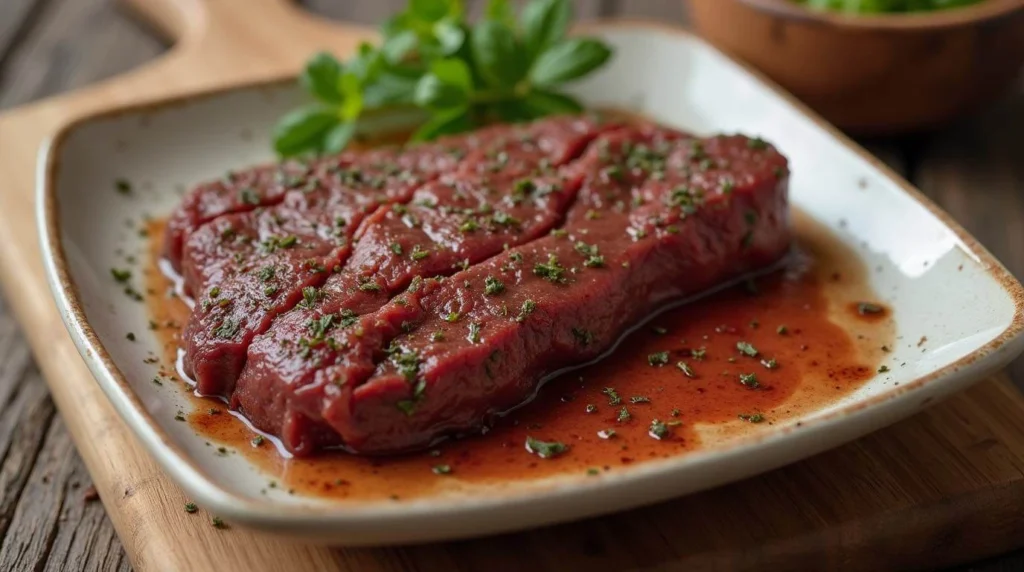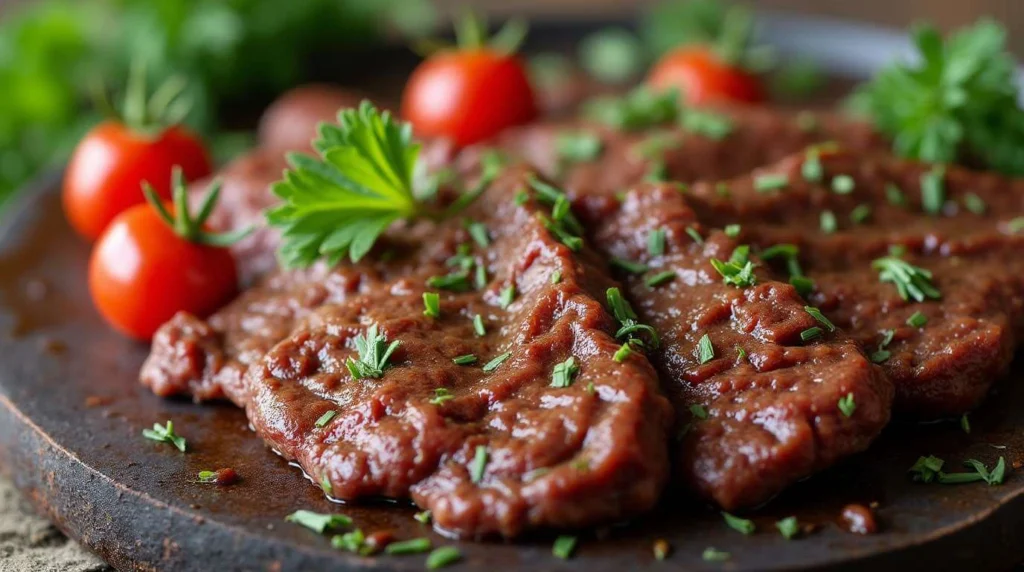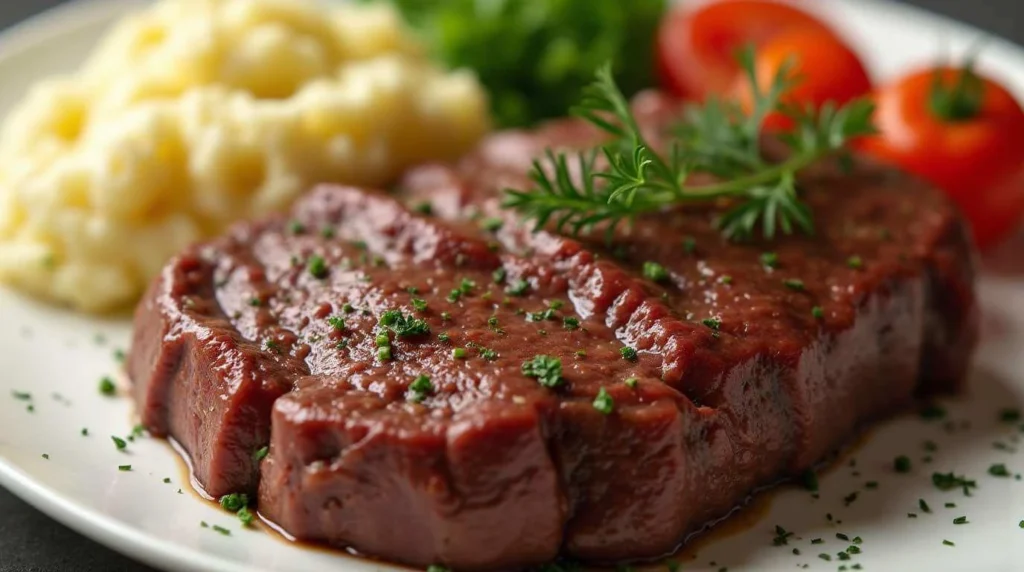Beef Liver
Ever feel like you’re stuck in a dinner rut, always using the same ingredients? It might be time to shake things up. Beef liver is more than just meat; it’s a treasure trove of nutrients. It’s packed with vitamins and minerals that can boost your health.
In this article, you’ll learn why beef liver is a game-changer for your diet. Plus, you’ll get tips on how to cook it to perfection. This will turn mealtime into an adventure, not a chore.
Beef liver is not only delicious but also nutritious. It has about 328 calories per serving and is high in protein. Just one serving gives you over 25,000 IU of Vitamin A, making it a superfood for your body (source:). Ready to make your meals and health better? Let’s explore the amazing world of beef liver together.
Introduction to Beef Liver
Beef liver has been a favorite in many cuisines for a long time. Yet, it’s less popular now than muscle meats. It’s packed with nutrients and has few calories. For every 100 grams, it has 135 kcal and 20 g of protein, which is great for your health.
Beef liver is also rich in vitamins and minerals. It has about 9,000 mcg of Vitamin A per 100 grams. This is way more than the daily needs of adult men and women. Plus, it’s a top source of Vitamin B12, with about 70 mcg per 100 grams. This is much more than the daily recommended amount of 2.4 mcg.
Beef liver is also high in heme iron, with about 6.2 mg per 100 grams. Heme iron is better absorbed than non-heme iron, helping your body get more iron. Eating beef liver regularly can boost your energy levels. It’s said to increase energy by 20-30% due to its B vitamins and iron. Adding beef liver to your diet can bring many health benefits, making it a key part of your meals.
Table of Contents
The Nutritional Profile of Beef Liver
Beef liver is packed with nutrients, making it a top choice for a healthy diet. A 113-gram serving has only 150 calories but offers 23 grams of protein. This shows beef liver is both high in protein and low in calories.
This makes it great for those who want to eat more protein without gaining weight.
High in Protein and Low in Calories
Beef liver is lean, meaning it’s full of nutrients but low in fat. Each serving has about 4.1 grams of total fat. This helps you get the nutrients you need without too much fat.
So, beef liver is a smart choice for anyone looking for a protein-rich food.
Vitamin and Mineral Abundance
Chicken liver is a powerhouse of essential nutrients and minerals. It’s loaded with vitamin A, giving you 380% of your daily needs in one serving. It also has nearly 50% of the daily B vitamins, 30% of iron, and lots of selenium and zinc.
This highlights the nutritional benefits of adding beef liver to your meals.
Comparison with Other Meats
When compared to other meats, beef liver is far more nutritious. Chicken and pork have their benefits, but beef liver beats them in iron, vitamin A, and B vitamins. These nutrients are key for energy, immune health, and brain function.
| Nutrient | Amount per 113g Serving | % Daily Value |
|---|---|---|
| Calories | 150 | N/A |
| Protein | 23g | N/A |
| Vitamin A | 5620mcg | 380% |
| Iron | 5.54mg | 30% |
| Zinc | 4.52mg | 40% |
| Selenium | 44.9mcg | 50% |
| Vitamin B12 | 67mcg | 988% |
| Copper | N/A | 488% |
Beef liver’s nutritional profile makes it a top pick for a healthy diet. It’s rich in vitamins, making it stand out from other meats. Adding beef liver to your meals can bring many health benefits.

Top 7 Health Benefits of Beef Liver
Beef liver is packed with nutrients that boost your health. It supports your immune system, increases energy, and improves vision and brain function.
Supports Immune Function
Beef liver is rich in vitamins A and B12, which are key for a strong immune system. These vitamins help make antibodies to fight off infections. It also has iron and copper, which help make red blood cells.
Boosts Energy Levels
Beef liver is a great source of iron, fighting iron deficiency anemia and fatigue. Its high protein content also helps control hunger and keeps energy levels up.
Promotes Healthy Vision
Beef liver is packed with vitamin A, giving over 100% of your daily value in a small serving. Vitamin A is vital for good vision, even in low light.
Enhances Brain Health
Beef liver is full of vitamin B12 and choline, which are essential for brain health. These nutrients boost cognitive function, improving memory and mental clarity.
Improves Muscle Mass and Repair
Beef liver has about 20.4 grams of protein per 100 grams, aiding in muscle repair and maintaining muscle mass. It’s perfect for those who are active or into bodybuilding.
Supports Skin Health
The nutrients in beef liver help keep your skin healthy and youthful. Vitamin A promotes clear, vibrant skin by supporting healthy skin cell production.
Aids in Detoxification
Beef liver contains glutathione, which helps detoxify your liver. Eating it regularly helps your body get rid of toxins, improving overall health.
The Importance of Grass-Fed Beef Liver
Eating grass-fed beef liver is more than just a taste preference. It’s packed with health benefits thanks to its rich nutritional value. Compared to grain-fed liver, grass-fed options offer better nutrients. They provide essential vitamins and minerals for your health.
Comparative Nutritional Value
A 113g serving of beef liver has about 150 calories. It’s a sustainable choice for those who want to eat well without harming the planet. The grass-fed liver has up to four times more nutrients than the grain-fed liver.
One serving gives you 23 grams of protein and 380% of your daily vitamin A. It also has nearly 50% of the daily B vitamins and 30% of the daily iron. The iron in the liver is absorbed better than iron from plants, thanks to its heme iron.
Ethical and Sustainable Choice
Choosing grass-fed beef liver boosts your nutritional value and supports ethical farming. It helps animals and the environment. Eating liver once a week is good for you and keeps you from getting too much of certain vitamins and minerals.
Adding grass-fed beef liver to your diet is a way to nourish yourself. It’s also a responsible choice for the planet.
How to Cook Beef Liver Perfectly
Cooking beef liver perfectly needs careful preparation and technique. Getting a tender liver is key. Using specific cooking tips can greatly improve your dish. Soaking the liver in buttermilk for 20 minutes to 2 hours can reduce bitterness and make it tender.
It’s also important to cook the liver at the right temperature. The internal temperature should reach 160°F. This ensures it’s both safe and tender.

Preparation Tips for Tender Liver
To prepare beef liver, cut it into even pieces. Lightly coating the liver in flour improves texture and helps get a crispy exterior. Using butter or olive oil keeps the liver moist.
Cook the liver for about 6 minutes. Cook for 3 minutes on one side, then flip and cook for an additional 2-3 minutes.
Cooking Techniques to Enhance Flavor
Using strong seasonings like garlic and herbs can enhance flavor. Cooking with onions adds sweetness and depth. Remember, the temperature may rise another 5°F after cooking, so watch closely.
You can also try grilling or braising for different flavors. The key is to cook precisely for the best taste and texture in your beef liver recipes.
Recommended Beef Liver Recipes
Cooking beef liver can be a fun journey to tasty and healthy meals. Here are some top beef liver recipes to spice up your cooking.
Beef Liver with Onions
This dish combines tender beef liver with sautéed onions for a delicious mix. It takes about 30 minutes to make, with 15 minutes for prep and 15 for cooking. Each serving has 225 kcal, 23 g of protein, and 11 g of fat, making it a great choice for any meal.
When cooking beef liver, aim for an internal temperature of 160°F. Cook each side for about 3 minutes while you cook the onions for 7-8 minutes. This will give them a sweet caramelized flavor.
Incorporating Liver into Spaghetti Bolognese
Add finely chopped beef liver to your Spaghetti Bolognese for a nutrient boost. The liver blends well with the sauce, adding vitamins without overpowering the dish. Cook the liver with the ground meat for 5 minutes before adding the sauce, keeping it tender and flavorful.
Creating Liver Burgers
Try making liver burgers by mixing chopped or blended beef liver with ground beef. This increases protein while keeping the flavor and moisture. Add seasonings like ground cumin or dried thyme for extra taste. Each burger has about 27 g of protein, making it a filling meal.
| Recipe | Total Time | Calories | Protein (per serving) | Fat (per serving) |
|---|---|---|---|---|
| Beef Liver with Onions | 30 minutes | 225 kcal | 23 g | 11 g |
| Spaghetti Bolognese with Liver | Approx. 30 minutes | Varies by additional ingredients | Varies based on portions | Varies |
| Liver Burgers | Approx. 25 minutes | Varies by recipe | 27 g | 6 g |
With these beef liver recipes, you can enjoy cooking beef liver in many tasty and healthy ways. They are sure to please the whole family.

Common Concerns About Eating Beef Liver
Beef liver is packed with health benefits, but some worry about its cholesterol and heart health effects. It’s important to know how it fits into your diet.
Cholesterol Content and Heart Health
Beef liver has a lot of cholesterol, which might worry some. But most people don’t see a big impact on their heart from eating it. A 113g serving has about 150 calories and 23 grams of protein, making it a good choice despite the cholesterol.
Eating beef liver regularly can boost memory and lower Alzheimer’s risk. But, it’s key to eat it in moderation.
Who Should Avoid Beef Liver?
Pregnant women and people with gout should steer clear of beef liver. It can cause vitamin A toxicity in pregnant women, which is risky for babies. Gout sufferers should also avoid it because of its high purine content.
For those without vitamin A deficiencies, it’s wise to limit beef liver to one or two servings a week. This helps avoid the risks of too much vitamin A.
Precautions When Eating Beef Liver
Eating beef liver can be good for your health, but there are things to watch out for. It’s key to keep an eye on how much you eat to avoid health problems.
Vitamin A Sensitivity
Beef liver is packed with vitamin A, giving you about 380% of what you need in one serving. Too much vitamin A can be harmful. So, eating liver in moderation is important to avoid health issues.
Considerations for Pregnant Women
If you’re pregnant, eating beef liver can be risky. Too much vitamin A can harm your baby’s growth. Doctors often tell pregnant women to avoid liver to keep both mom and baby safe.
Impact on Individuals with Gout
If you have gout, eating beef liver might not be a good idea. Liver and other organ meats have a lot of purines. This can make uric acid levels go up and make gout worse. People with gout should choose foods with less purine.
Choosing the Right Beef Liver
Choosing the right beef liver means looking at its freshness and where it comes from. Look for a liver that’s bright red and has a smooth feel. If it’s not red or feels slimy, it’s not fresh. Also, steer clear of any liver with a bad smell.
Quality liver comes from trusted sources. You can find it in grocery stores, markets, or butcher shops that sell grass-fed meats. These places help you get liver that’s full of nutrients and fits your diet.
Identifying Fresh Beef Liver
Here’s how to spot fresh beef liver:
- Bright red color
- Smooth and firm texture
- No foul smell or sliminess
These signs mean you’ve got the best organ meat.
Where to Purchase Quality Organ Meat
You can buy quality organ meat in different places. Consider:
- Local butcher shops that focus on grass-fed products
- Organic food stores with high-quality meats
- Online stores that specialize in organ meats
For a good serving size, get about 1 lb of beef liver for four people. Beef liver is packed with protein, about 29.1 grams per 100g, and important nutrients for health.
Storing and Reheating Leftover Beef Liver
Have leftover beef liver? It’s key to store and reheat it right to keep its taste and nutrients. Learning how to store beef liver well lets you enjoy it fully.
Proper Storage Techniques
For the best storage, refrigerate beef liver quickly in a sealed container. The USDA says to eat cooked liver within 1 to 2 days for safety. Keep your fridge at or below 40°F (4°C) for freshness. If it’s slimy, smells bad, or looks different, it’s time to throw it away.
Freezing beef liver keeps it fresh for months. But it tastes best within 3 to 4 months. Don’t let cooked liver sit at room temperature for over 2 hours.
Reheating Tips to Retain Flavor
To reheat beef liver, use methods that keep the flavor. The best way is to use a low oven setting. This method gently warms the liver, keeping it moist and tasty. Serve it at or above 160°F (71°C) for safety before refrigerating. Try to avoid microwaving as it can dry out the meat.
By following these tips, you’ll always have delicious and healthy beef liver.
Benefits of Incorporating Organ Meats into Your Diet
Adding organ meats to your diet is a smart move for your health. They are full of vitamins and minerals, making them a great choice. Beef liver, in particular, is packed with nutrients, unlike regular meat. This section will show how these foods can make your diet better and how versatile they are in cooking.
Getting More Nutrients from Organ Meats
Organ meats are a treasure trove of essential nutrients. They are rich in vitamins A, B2, and B12, which help fight chronic diseases. They also have minerals like copper, which boost your immune system and brain health. For those with anemia, the liver is a game-changer because it’s low in calories but high in protein and iron.
Studies show that eating iron-rich organ meats can greatly improve anemia symptoms. Young people, in particular, can see quick improvements in their health with regular liver consumption 25.
Culinary Versatility of Organ Meats
Organ meats are also incredibly versatile in cooking. They can be used in everything from hearty stews to fancy dishes. Beef liver, heart, and kidney are great additions to many meals, adding flavor and nutrients. The “nose to tail” approach, using all parts of the animal, is a great way to get more nutrients and reduce waste.
Organ meats offer nutrients that are easier for our bodies to use than those from plants. Many are now adding these foods to their daily meals for their health benefits and delicious taste. This change not only makes meals healthier but also celebrates a cooking tradition that’s worth keeping.
| Nutrient | Organ Meat Source | Health Benefit |
|---|---|---|
| Vitamin A | Beef Liver | Supports gut lining integrity and immune function |
| Iron | Spleen Meat | Essential for gut health and red blood cell production |
| Copper | Organ Meats | Boosts immune system and aids brain development |
| Omega-3 Fatty Acids | Beef Organs | Reduces inflammation and supports gastrointestinal health |
| Choline | Beef Liver | Supports liver function and optimal digestion |

The Historical Perspective on Eating Liver
Beef liver has been important in many cultures for its nutritional value and health benefits. It’s been a key part of meals worldwide, showing respect for this organ meat. Learning about its history can help us see why the liver is valuable and might make us want to eat more of it today.
Traditional Uses of Beef Liver in Various Cuisines
In many places, beef liver is used in special ways, showing its value and health benefits. For example, in Pakistan and North India, it’s the first meat eaten during Eid al-Adha, a time of celebration and family. In Hawaii, Okinawans eat pig liver on New Year’s Eve, adding cultural importance to the day. These traditions show that the liver’s role goes beyond just food, connecting to the heart of cultures.
The liver is full of vitamins and minerals, making it a healthier choice than many meats. This has kept it in many diets, where it’s often mixed with local foods to make tasty dishes. The history of eating liver shows it’s linked to available resources and cultural practices.
| Country/Region | Traditional Use | Notable Dishes |
|---|---|---|
| Pakistan/North India | First meat consumed during Eid al-Adha | Bhuni Kaleji (spiced liver) |
| Hawaii | Consumption on New Year’s Eve | Pork liver stew |
| France | Key ingredient in pâté | Pâté de foie |
| Russia | Part of traditional dishes | Beef liver stroganoff |
The liver’s role in food and culture is worth exploring. Looking at its history can help us see organ meats in a new light. It encourages us to try these nutritious foods in our cooking.
Consumer Trends and Organ Meat Popularity
Recently, people have started to choose nutrient-dense foods more often. Organ meats like beef liver are becoming popular. This change shows that people are more aware of health and want to eat sustainably.
The Shift Towards Nutrient-Dense Foods
Organ meats are now seen as superfoods because they offer extra protein, vitamins, and minerals. The beef liver market size was over USD 5.73 billion in 2024. It’s expected to grow to USD 15.03 billion by 2037. More people are looking for meat blends that include organ meats to boost their nutrition.
Growing Interest in Sustainable Eating
There’s a growing interest in eating sustainably. This has led to more demand for grass-fed beef liver. One-quarter of beef liver is protein, which appeals to those who care about their health. The market for beef liver is expected to grow at a steady rate of around 7.7% from 2025 to 2037.
Conclusion
Adding beef liver to your meals offers many health benefits and nutrients. It’s packed with vitamins and minerals, making a small amount count for a lot. For example, it gives you over 200% of the daily recommended dose of vitamin A and 65 times the recommended dose of vitamin B12 you need.
This organ meat is great for your body and health. It’s a top pick for boosting your nutrient intake.
Learning how to cook beef liver makes it tasty and fun to eat. Try marinating or sautéing it to bring out its flavors. This way, you enjoy eating it while getting its health perks.
Eating beef liver once or twice a week is a good way to add it to your diet. It helps you stay balanced and avoid overeating.
Choosing beef liver for your meals is good for you and the planet. It’s part of the trend toward eating foods full of nutrients. Organ meats like beef liver are key to a healthy, balanced diet.
By eating beef liver, you’re not just feeding your body. You’re also joining a movement toward better food choices.
FAQ
What are the health benefits of beef liver?
Beef liver is packed with nutrients. It boosts your immune system and energy. It also helps your vision, brain, muscles, and skin, and detoxifies your body.
How should I prepare beef liver to make it tender?
Soak the liver in buttermilk for 10 to 60 minutes. This makes it less bitter and tender. Cook it for about 3 minutes on each side to avoid a tough texture.
Is grass-fed beef liver better than grain-fed?
Yes, grass-fed beef liver is better. It has more nutrients and supports sustainable farming. It has more vitamins and minerals than grain-fed liver.
Can I eat beef liver if I’m concerned about cholesterol?
Beef liver has a lot of cholesterol. But research shows it doesn’t harm most people’s hearts. If you have health issues, talk to a doctor first.
What are some easy recipes for cooking beef liver?
Try beef liver with onions, add it to spaghetti Bolognese, or make liver burgers. These recipes add nutrition without losing flavor.
Who should avoid eating beef liver?
Pregnant women, people with gout, and those sensitive to vitamin A should limit or avoid beef liver. It can pose health risks.
How do I know if beef liver is fresh?
The fresh liver is deep red or purplish, firm, and smells good. Buy from trusted sources or specialty butcher shops for the best quality.
How should I store leftover beef liver?
Store leftover liver in a sealed container in the fridge for 2-3 days. Reheat it in the oven to keep it moist and flavorful.
What makes organ meats like beef liver a good dietary choice?
Organ meats are super nutritious, with more vitamins and minerals than regular meat. They’re also versatile in cooking, making dishes richer.
What historical significance does the beef liver have in various cultures?
Beef liver has been prized for its health benefits for centuries. It’s a key ingredient in many cuisines worldwide and is known for its nutritional value.


Comments are closed.